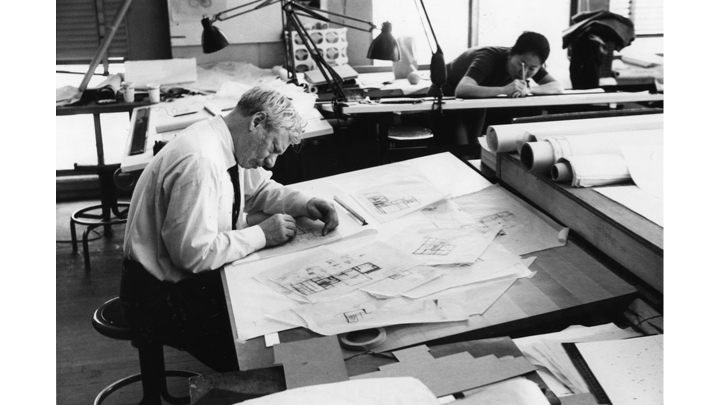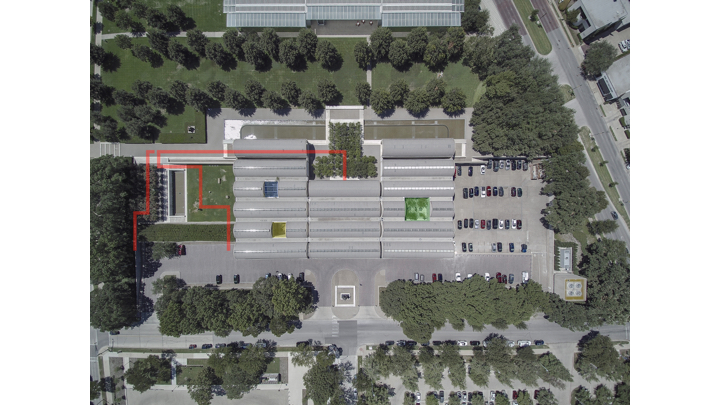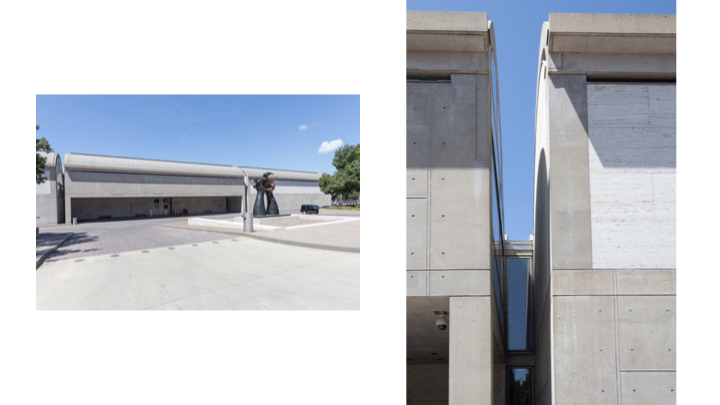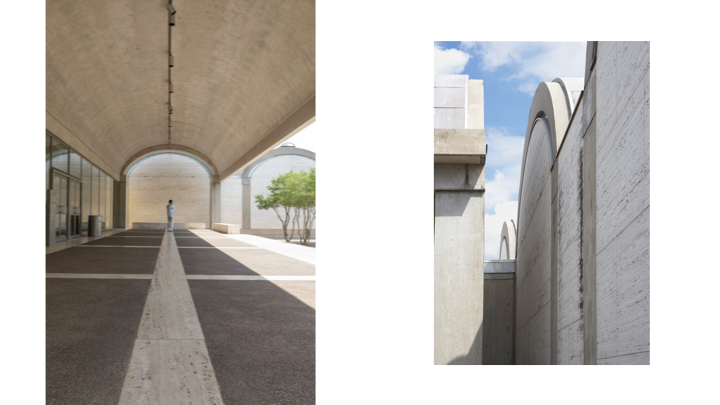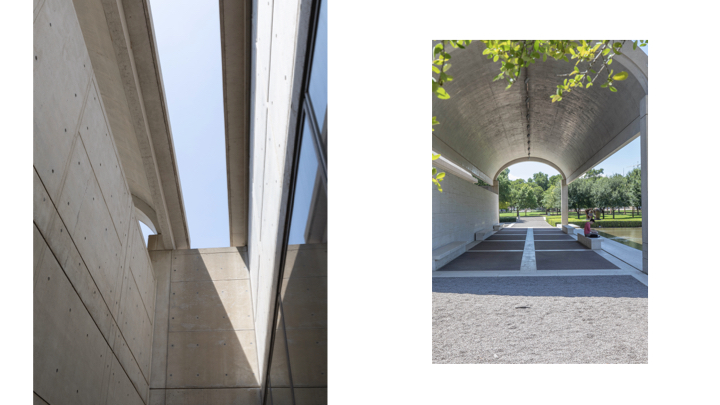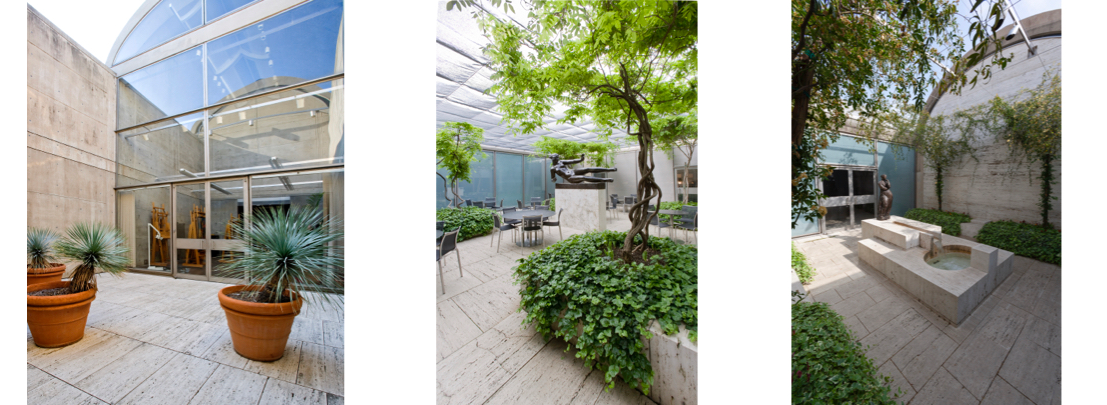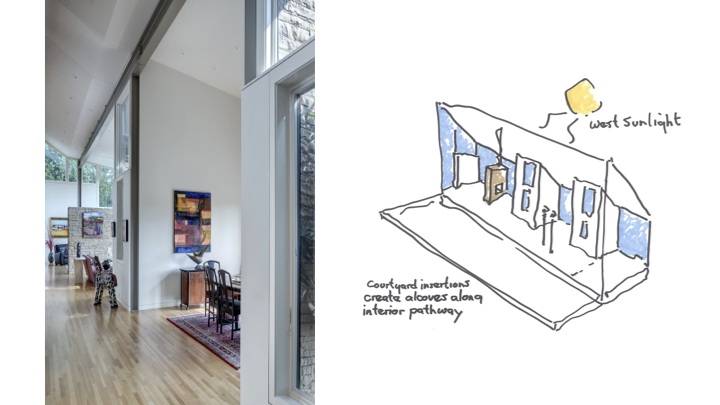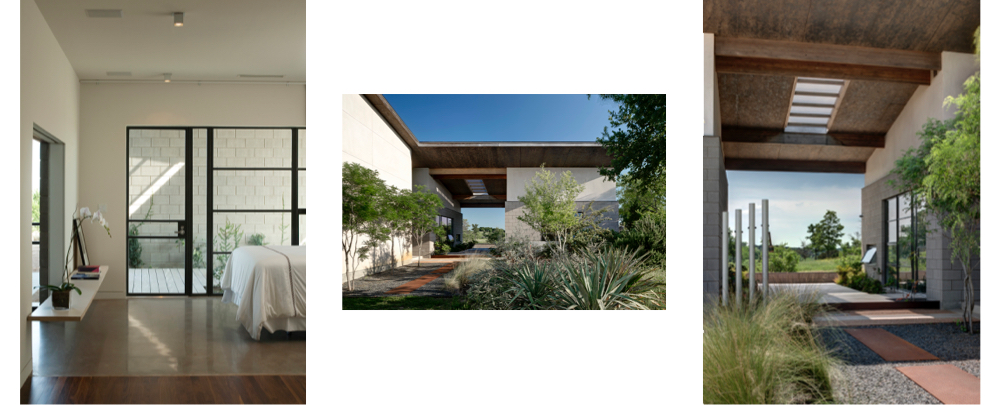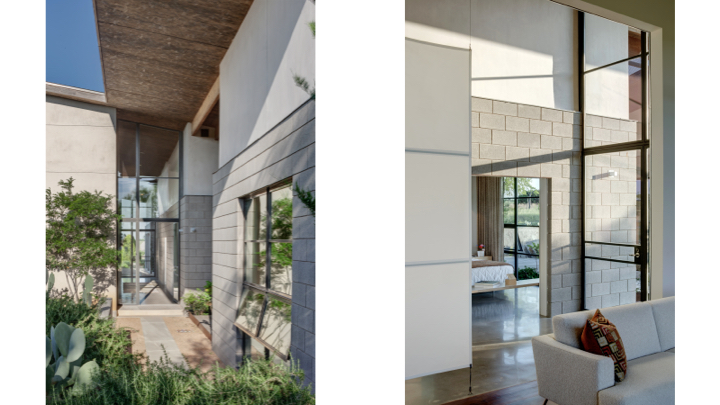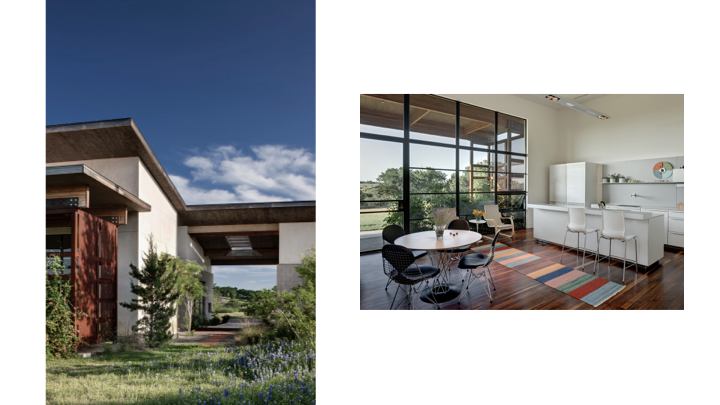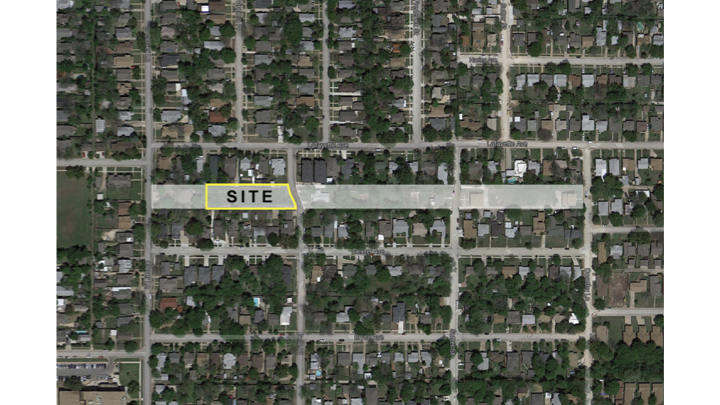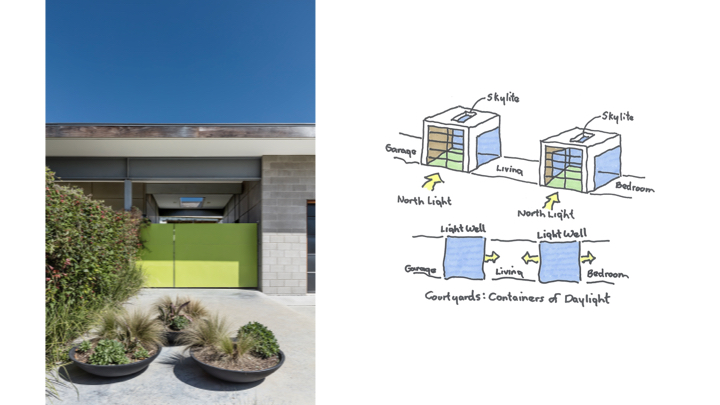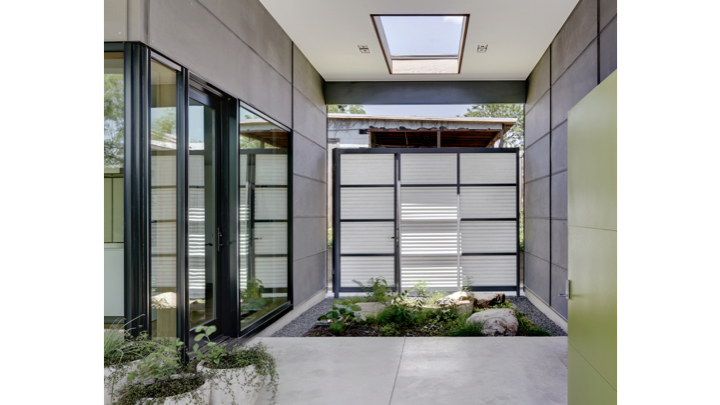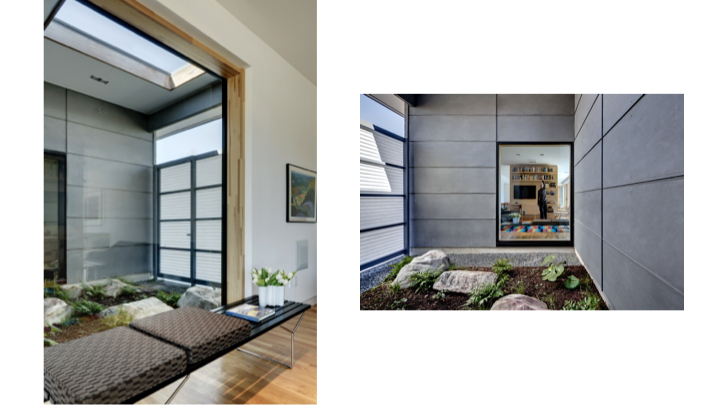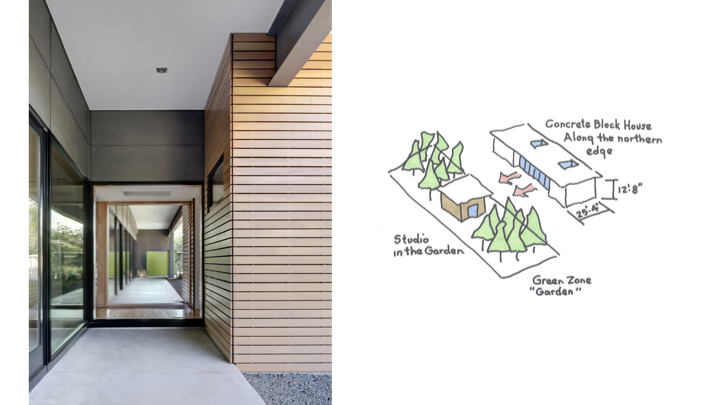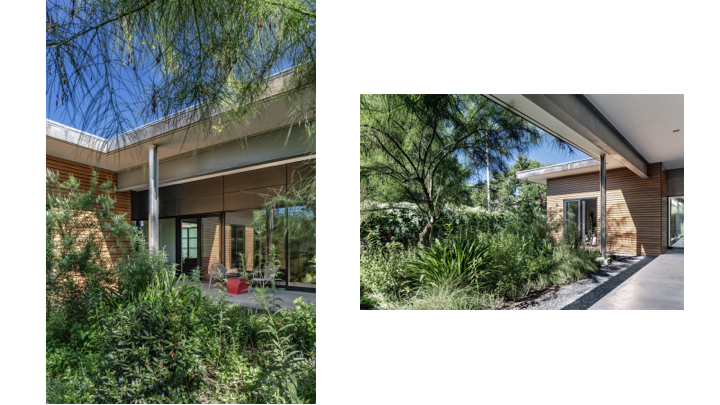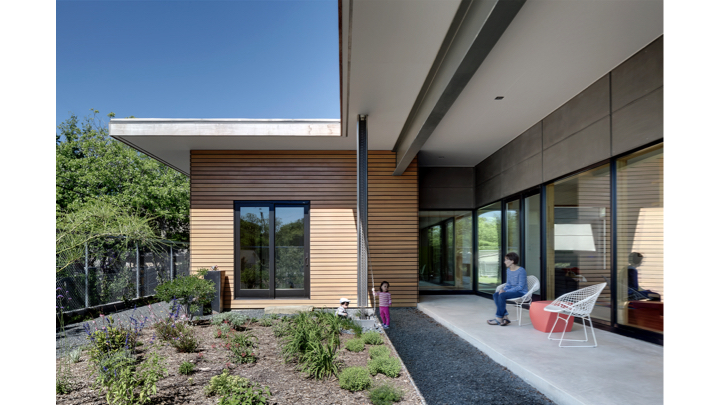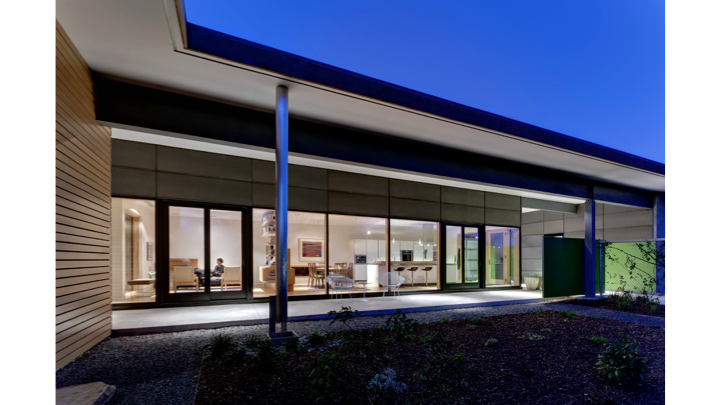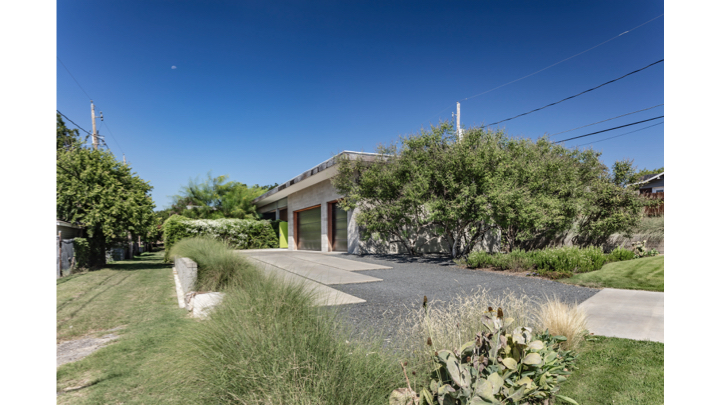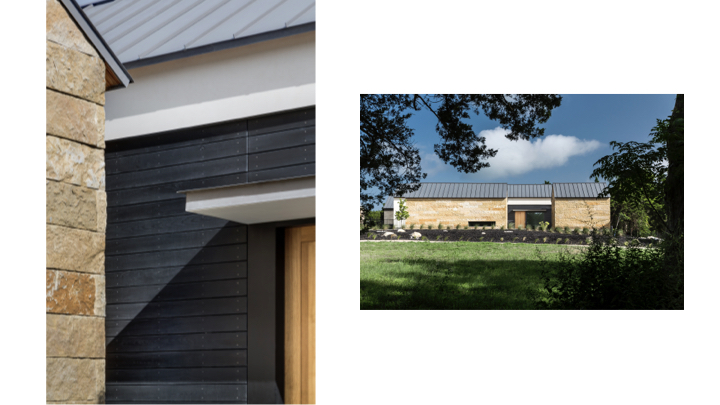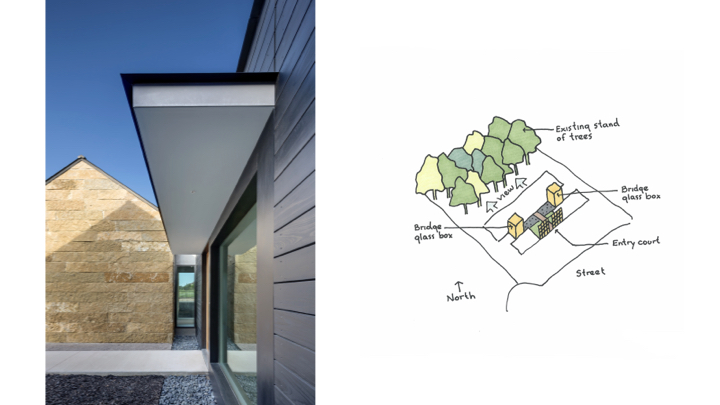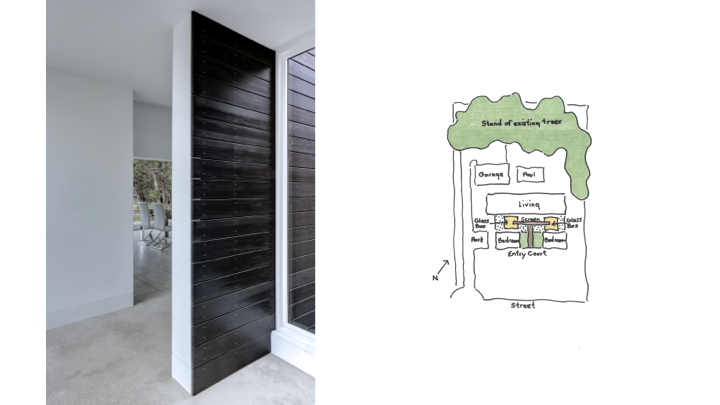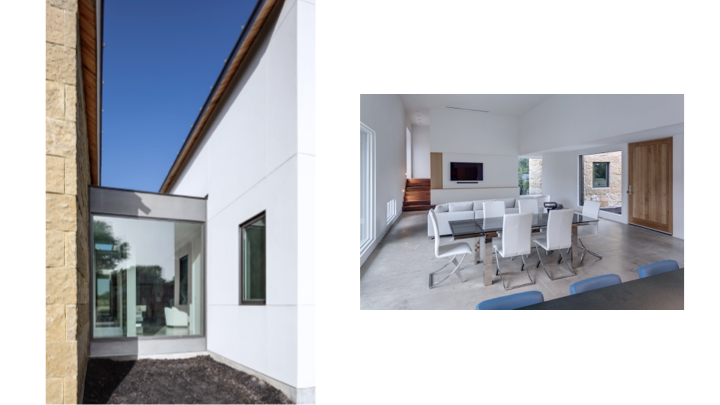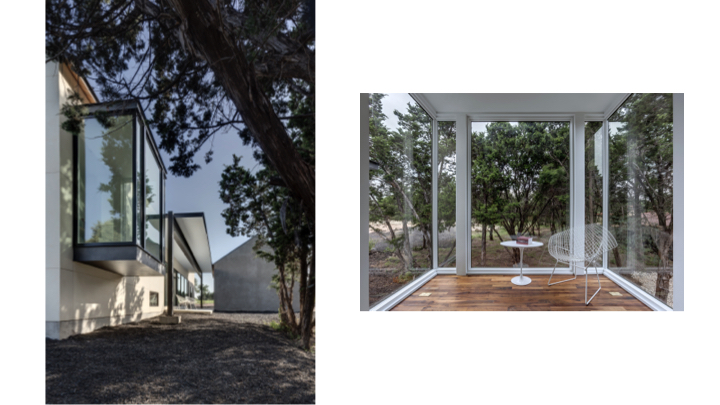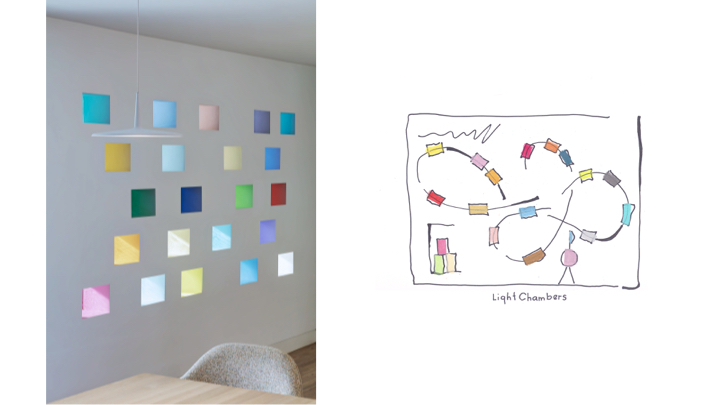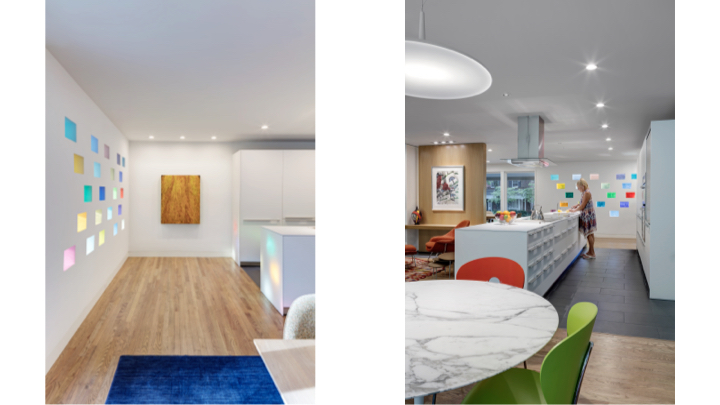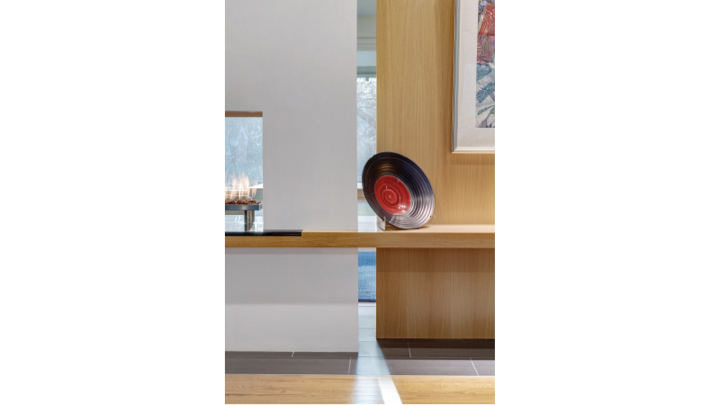Louis Kahn’s Kimbell Art Museum and his words have influenced many architects, including myself. I have also been fascinated with people who draw since I was a small child. I am not sure how you might perceive this image of Louis Kahn. For me, I see a person in a private conversation. Knowing this is a man filled with creativity and soon his thoughts will become realized in his buildings for all of us to know.
This is an Arial of the Kimbell Art Museum. I would like to make a note. Landscape architect Harriet Pattison along with Landscape architect George Patton collaborated with Louis Kahn on the Kimbell Art Museum’s landscape design. The three interior courtyards are graphically highlighted with green, yellow, and blue, named for the type of light Mr. Kahn anticipated each courtyard would give. Even though the dimensions of the courtyards and porches will give a better understanding of Mr. Kahn’s ideas, this should be a separate presentation. The red line will be the path we will follow leading us to the main entry.
My first observation arriving by car to the museum is the solidness of the building and appearing to be void of the possibly of the sun’s light to enter the museum. Then I realize the joint Mr. Kahn created between the vaults invite the sun’s light into his building. Not only is the light entering the lower and upper galleries through the narrow slot of glass, the ends on both sides of the upper center vault is filled with glass. The sun’s light enters into the offices and library behind the bookstore area. The entry doors facing the parking area are set into a concrete wall, recessed into the lower level. These are the doors most visitors enter from the parking. However, our path will take us on a journey through courtyards and porches arriving to the main entry on the west side of the Museum.
From the parking area, a narrow passageway leads into a sky filled sunken courtyard. There is not a discernible path through the grass courtyard. Interestingly, this journey leads away from the museum building, A casual stroll through the grassy courtyard leads to a reflecting pool flanked by stairs. Walking up the steps you arrive under the canopy of Crepe Myrtles placed in crushed granite. You have arrived under a canopy of light and shadow. A second entry is located to the far south end of the parking area. These travertine steps lead up to the grove of Crepe Myrtles overlooking the sunken courtyard.
Both paths lead to a wide walkway connecting Camp Bowie Boulevard on the north and Lancaster Avenue on the south. Leaving the shadow filled Crepe Myrtle Canopy, our journey takes a turn to the right. At this point, the vaulted galleries come into full view. Walking on the crushed granite towards the porch, the sound of running water becomes noticeable as the sounds of automobiles disappear. The porch provides shelter under an open vault. A two level pool fronts the porch. Water pours in a smooth sheet into the lower pool. Under the porch vault, the crushed granite is placed in concrete interlaced with travertine.
Leaving the porch, the visitor once again arrives under a canopy of light and shadow, a grove of Yaupon Hollies placed in crushed granite. This is the west entry court into the museum. This image shows the pool in front of the porch. You can see the reflection of trees and sky on the surface of the pool. Travertine steps lead up onto the entry porch with a fully glazed wall facing the entry courtyard.
The joint between the entry porch and vaulted gallery become a source for the sun’s light to be cast onto the travertine wall.
Behind the Porch walls is a long narrow courtyard, open to the sky. Louis Kahn offers the sun’s light to the Museum staff. The courtyard brings ambient light into the lower level administrative offices behind south porch and the shop area behind the north porch.
The Conservation Court is located on the lower level and its walls extend through an upper gallery. This courtyard is not accessible to the visitor. The sun’s light in this court is offered to the administrative staff. Louis Kahn referred to this court as the Yellow Court. Both of these courtyards are shared with the visitor. Louis Kahn referred to the courtyard on the left as the Green Courtyard. This courtyard is enclosed on four sides with glass. The Blue Courtyard on the right is accessible through two galleries opposite one another. The sound of running water is introduced into this courtyard. All three courtyards were named for the type of light Mr. Kahn anticipated each courtyard would give. Courtyards, porches, and even breezeways have been a large part of my work. Celebrating the sun’s light and shadows is an on going pursuit.
The Williamson Residence was the first house I designed. The entry porch faces south. This was the beginning of porch and courtyard design for my work. Entry into the house is not revealed from the street. Walking towards the porch, the entry is revealed. There is a private courtyard on the east end of the porch. There is the sound of running water within the small courtyard. These are images inside the courtyard. The courtyard can open or close for privacy.
In the Holub Residence, a pair of cubic pavilions brackets the entry courtyard. Passage into the south-facing courtyard is through an open-air wood screen with a steel-blade canopy. The screens serve to filter the sun’s light. Light and shadow fill the courtyard. The wood walkway is suspended above the landscape leading to the front door, flanked by fixed wood panels that seem to be pulled open for entry.
In the Bird Residence, the entry concrete steps lead up to a wooded bridge. The entry wall and ceiling is stained Ipe flanked with sandstone veneer walls. The porch has a deep roof overhang with wood fins inserted into an opening. The roof fins serve as a light baffle allowing sun’s light and shadow to fall onto the wood bridge.
In the Smith Residence, two courtyards form alcoves for the living and dining areas. Large windows are placed above small operable windows to bring ambient light deep into the interiors.
Bluestem is my house, composed of 4 pavilions resting under a single roof canopy. Windows are minimized on the southern face shielding the interiors from the Texas sun, while two breezeways and a north porch filter sunlight entering the interiors. The breezeways allow for southern breezes to flow under the roof canopy. The raised wood walkway is a bridge connecting the landscape on the south with the landscape on the north.
A roof portal with a steel perforated panel is cut above each breezeway to allow the movement of the sun’s light to be cast onto the east and west walls, creating an awareness of the passage of time. The two-foot wide steel plate over basalt gravel became the pathway through the courtyard. Two feet is an approximate width of one’s shoulders, causing individuals to walk in single file through the courtyard.
The long hallway runs east to west. There is a moment in the morning when the sun’s light extends deep into the hallway, and then falls away. In the afternoon the sun’s light extends deep into the hallway from the opposite end of the house and then falls away. The interiors are in soft daylight except for these two moments in time.
I added perforated metal screens on the east and west ends of the north porch. The screens filtered the direct sunlight entering the living areas in the summer months. The sun rises and sets much further north in the summer months. Before adding the perforated screens, harsh sunlight was coming into the living areas from the sides of the porch.
The Moretti Residence is located in a fairly dense neighborhood. A green zone extending for three blocks appear to be left over from the merging of two developments. In time a house was placed on each end of each block. The Moretti’s purchased one of these lots, 60’ x 300’. So the question came, how to introduce the sun’s light into the house and yet provide privacy from the neighboring houses.
Two cubic courtyards are inserted within the house. They serve as “light wells” filling the interiors with ambient light. The green panel is the entry into the house.
The north wall of the courtyards is composed of a steel frame with white translucent panels. The movement of sunlight is cast onto these panels through the roof portal, reflecting the passage of time. The translucent panels also serve as a privacy screen from the neighboring houses. The sun’s light enters the interiors through these two courtyards.
A glass bridge connects the main house to the studio placed within the garden. The deep overhang above the south-facing porch prevents direct sunlight from falling onto the window wall. The porch runs the length of the garden and serves as a threshold between the interiors and the landscape.
The south courtyard is enclosed within a “garden wall” of Cross vine and Autumn Clematis. The landscape attracts butterflies, small birds, and bees. The living areas and kitchen views are into this courtyard. From inside the house, one can experience nature year around.
Courtyards and gardens take time to mature. In this case, 5 years. A rain chain is designed with eight chains, one for each grandchild, in an embrace of aluminum pipe that represents their grandmother. This images shows how the interiors and landscape are visually connected.
The street elevation gives an appearance of solid. Once past the green entry gate, the courtyards open to the sky through the roof portals and the living areas open to a private garden filled with light and shadow.
In the Huynh Residence, the stone pavilions appear to be pulled open to create entry into the house. The entry wall is sheathed in a cypress rain screen. Two-glass box are inserted into the composition. The glass boxes serve as containers for daylight. The box on the east collects the morning light while the box on the west collects the afternoon light. Daylight from the courtyard enters the glass boxes through a narrow slot of glass inserted between the cypress rain screen and bedroom pavilions. The wall merges into the glass boxes to create a visual buffer between the bedroom pavilions and living areas. Passage into the bedroom pavilions is through the glass boxes.
Steps lead to the glass-enclosed reading alcove, which opens to the northern daylight. The reading alcove is elevated above the exterior ground plane offering protected views into the tree canopy.
A renovation to Deborah Freed and Pat Higgins house is called 22 Glass Billets. The glass billets are imaged as musical notes set within an invisible stave. Afternoon sunlight releases the color of glass billets embedded in the west wall of the entry porch. These colors move about the rooms, reflecting off surfaces and dancing on the floor until the day comes to an end. And a beautiful joint was made for the afternoon light to enter deep into the house.
Lessons learned from Louis Kahn’s Kimbell Art Museum: The Sun’s light moves about courtyards, breezeways, and porches; interiors are filled with changing ambient light until the day draws to an end. Morning begins a new day and the Sun’s light once again fills these rooms.
